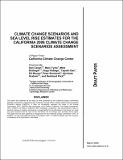Mostrar el registro sencillo del ítem
Climate change scenarios and sea level rise estimates for California 2008 Climate Change Scenarios Assessment
| dc.creator | Cayan, Daniel R. | |
| dc.creator | Tyree, Mary | |
| dc.creator | Dettinger, Michael D. | |
| dc.creator | Hidalgo León, Hugo G. | |
| dc.creator | Das, Tapash | |
| dc.creator | Maurer, Edwin P. | |
| dc.creator | Bromirski, Peter | |
| dc.creator | Graham, Nicholas A. J. | |
| dc.creator | Flick, Reinhard | |
| dc.date.accessioned | 2017-05-30T21:42:44Z | |
| dc.date.available | 2017-05-30T21:42:44Z | |
| dc.date.issued | 2009-03 | |
| dc.identifier.citation | https://www.sciencebase.gov/catalog/item/51701361e4b05024ef3cd662 | |
| dc.identifier.other | CEC-500-2009-014-D | |
| dc.identifier.uri | https://hdl.handle.net/10669/29848 | |
| dc.description | Cayan, D., Tyree, M., Dettinger, M., Hidalgo, H., Das, T., Maurer, E., Bromirski, P., Graham, N., and Flick, R., 2009, Climate change scenarios and sea level rise estimates for California 2009 Climate Change Scenarios Assessment: California Energy Commission Report CEC-500-2009-014-D, 50 p. (on-line report in pdf format, 1851 KB) | es_ES |
| dc.description.abstract | For the 2008 California Climate Change Assessment, to further investigate possible future climate changes in California, a set of 12 climate change model simulations was selected and evaluated. From the Intergovernmental Panel on Climate Change Fourth Assessment activities projections, simulations of twenty-first century climates under a B1 (low emissions) and an A2 (a medium-high emissions) emissions scenarios were evaluated. Six climate models were chosen. These emission scenarios and climate simulations are not “predictions,” but rather are possible scenarios of plausible climate sequences that might affect California in the next century. Temperatures over California warm significantly during the twenty-first century in each simulation. Also the rise in global sea level, and by extension the rise of sea level along the California coast, increases. Along with this, there are marked increases in the frequency, magnitude, and duration of heat waves and sea level rise extremes. There is quite a strong inclination for higher warming in summer than winter and greater warming inland than along the coast. In several of the simulations there is a tendency for drier conditions to develop during mid-and late-twenty-first century in Central and Southern California, and along with this, a decline in winter wave energy along the California coast. | es_ES |
| dc.description.sponsorship | California Energy Commission’s Public Interest Energy Research (PIER) Program, United States, California | es_ES |
| dc.description.sponsorship | National Oceanic and Atmospheric Administration’s Regional Integrated Sciences and Assessments (RISA) Program , United States, California | es_ES |
| dc.description.sponsorship | U.S. Geological Survey Priority Ecosystems Study of the San Francisco Estuary | es_ES |
| dc.language.iso | en_US | es_ES |
| dc.source | California Energy Commission | es_ES |
| dc.subject | California | es_ES |
| dc.subject | Hydrology | es_ES |
| dc.subject | Sea level | es_ES |
| dc.subject | Climate change | es_ES |
| dc.title | Climate change scenarios and sea level rise estimates for California 2008 Climate Change Scenarios Assessment | es_ES |
| dc.type | informe científico | |
| dc.description.procedence | UCR::Vicerrectoría de Investigación::Unidades de Investigación::Ciencias Básicas::Centro de Investigaciones Geofísicas (CIGEFI) | es_ES |
Ficheros en el ítem
Este ítem aparece en la(s) siguiente(s) colección(ones)
-
Meteorología [509]


